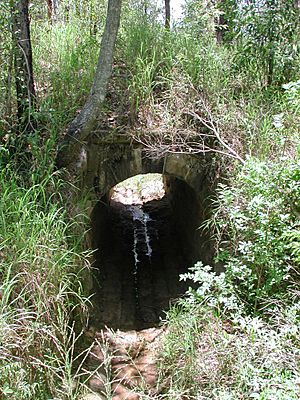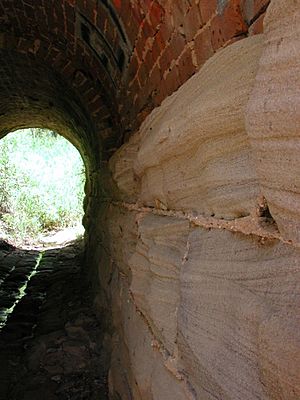Sandstone Railway Culvert, North Ipswich facts for kids
Quick facts for kids Sandstone Railway Culvert, North Ipswich |
|
|---|---|

Sandstone Railway Culvert, 2004
|
|
| Location | about 130m west of the corner of WM Hughes Street and Musgrave Street, North Ipswich, City of Ipswich, Queensland, Australia |
| Built | 1864-1865 |
| Official name: Sandstone Railway Culvert | |
| Type | state heritage (built, archaeological) |
| Designated | 13 November 2008 |
| Reference no. | 602562 |
| Significant period | 1860s |
| Lua error in Module:Location_map at line 420: attempt to index field 'wikibase' (a nil value). | |
The Sandstone Railway Culvert is a special old tunnel for water in North Ipswich, Queensland. It's located about 130 meters west of the corner of WM Hughes Street and Musgrave Street. This culvert was built a long time ago, between 1864 and 1865. It's considered an important historical site and was added to the Queensland Heritage Register on November 13, 2008.
Contents
Discovering Queensland's First Railway Culvert
The Sandstone Railway Culvert was built around 1865 in North Ipswich. It's found near the old North Ipswich Railway Workshops. This culvert is one of the very few original parts left from Queensland's first main railway line. This railway was built between 1864 and 1865.
Why Railways Were Built in Queensland
In the past, Queensland's government wanted to build railways. They believed trains would help the state grow and improve life for people. Trains could carry goods cheaper and faster. They also made travel quicker for passengers. Roads were often very bad, especially when it rained. This made it hard to move goods, so railways were a great solution.
Choosing Ipswich for the First Railway
The town of Ipswich was chosen as the starting point for the first main railway line. This was instead of Brisbane. Ipswich was very important to farmers and ranchers from the Darling Downs area. It was a key meeting point for routes to the Darling Downs and the Upper Brisbane Valley. Ipswich was also a major river port for these farmers. Many people in Ipswich wanted their town to be Queensland's capital. Brisbane became the capital, but Ipswich stayed an important regional center.
Building the First Railway Line
The main engineer for building the railway was Abraham Fitzgibbon. He later became Queensland's first Commissioner for Railways. An English company, Charles Fox and Son, helped with the plans. Peto, Brassey and Betts, a company with lots of experience building railways worldwide, was hired to construct the line.
Work on the first railway section began on February 25, 1864. This was between Ipswich and Bigge's Camp (now Grandchester). Lady Diamantina Bowen officially started the work in North Ipswich. The first part of the line crossed the Bremer River near the Ipswich railway station. It then followed the north bank past the North Ipswich Railway Workshops. The line officially opened on July 31, 1865.
How Culverts Were Designed and Built
The culverts built for the Southern and Western railway lines followed special designs. These designs were approved by Abraham Fitzgibbon in 1863. Culverts were made from stone or timber. Concrete was not used for culverts in Queensland until the 1880s.
The North Ipswich culvert was built to a standard design for 4-foot wide brick culverts. It had a floor and sides made of cut sandstone. The arched roof was made from two layers of bricks. Another culvert near Wulkuraka was built for 6-foot wide brick culverts. We don't know of any complete timber culverts left from this early line.
Changes to the Railway Line
In 1875, the first part of the railway line was changed. This included the 6-kilometer section between North Ipswich and Wulkuraka, where the culvert is. A shorter line was built to the south of the Bremer River. This new line was part of connecting the main railway line to Brisbane.
Connecting to Brisbane by rail made river trade on the Bremer and Brisbane Rivers less important. It meant the end of Ipswich as a major river port. A small part of the old line, including the culvert, was kept. It was used to serve the Railway Workshops and a small coal mine.
A Rare Piece of History
The North Ipswich culvert is one of only three known culverts from Queensland's first main railway line. The other two are near Wulkuraka. These are the oldest known railway culverts still standing in Queensland. They are very important historical structures.
What the Culvert Looks Like
The Sandstone Railway Culvert is in a deep dip in the ground. It's about 130 meters west of WM Hughes Street and Musgrave Street in North Ipswich. It's located on a large piece of undeveloped land that slopes down towards the Bremer River.
The culvert is like a long tunnel, about 1.2 meters wide. It runs under an unsealed road. The floor and the lower part of the sides are lined with rough-cut sandstone blocks. The blocks on the floor are long and thinner than the ones on the sides. There are two layers of blocks on each side. The arched roof of the tunnel is made of bricks.
The entrances of the culvert, called portals, are made from smoothly cut sandstone. This stone is shaped to form an arch. You can't see the brick roof from the outside. At the eastern end, the arched sandstone entrance meets a wall made of rough-cut sandstone blocks. Both entrances are partly hidden by plants at the bottom of the dip.
Why the Culvert is Protected
The Sandstone Railway Culvert was added to the Queensland Heritage Register on November 13, 2008. It met several important rules to be listed.
Showing Queensland's History
This culvert is important because it shows how Queensland's history developed. It's an original part of Queensland's first main railway line, built around 1865. This railway line, from Ipswich to Grandchester, started Queensland's train network. It was a big step for the state's economy and how people lived.
The culvert is also part of an old section of the railway line that is no longer used. It shows what was important to the government in the 1860s. They chose to end the first railway line at Ipswich because it was a river port for farmers. This decision showed how important these farmers were and their need for faster ways to transport goods to the port.
A Rare Historical Find
The North Ipswich culvert is rare because it's one of the few original parts left from Queensland's first main railway line. The culverts at North Ipswich and Wulkuraka are the only original culverts from this first line that are still complete. They are the oldest railway culverts known to exist in Queensland.
Showing How Things Were Built
The culvert is a very complete example of how brick culverts were designed for the Southern and Western Railway. It follows the design approved by the Chief Engineer, Abraham Fitzgibbon, in 1863. It has sandstone floors and sides, with an arched roof made of bricks.



